America’s Fault Line
“Any country that accepts abortion is not teaching its people to love, but to use any violence to get what they want. This is why the greatest destroyer of love and peace is abortion.” Saint Teresa of Calcutta
Most of us are familiar with the major geological fault lines that run through the United States—the San Andreas fault that runs under the state of California, and the New Madrid fault that is centered in our own state of Missouri in its “bootheel.” Earthquakes emanate from these faults when the geological plates force themselves against one another and release energy.
One could use the same terminology for the two human rights issues that have framed our nation’s relatively young history: slavery and abortion. There have been other matters of consequence in our nation’s history, but these more than any other have provided the fault lines around which Americans have (and are) deciding what kind of nation we will be.
Many remark about the polarization and division that characterizes much of our political discourse and practice today. It was not always so. One could argue that as the major political parties have become more starkly identified around the issue of abortion, the political polarization has intensified, and for reasons that are understandable.
This issue is not about economic policy, or foreign policy, but something much more profound: When does human life begin? Do unborn human children have the same rights in the Declaration of Independence as the already-born? Should some human beings have power over whether other human beings live or die? It cannot escape us that these are essentially the same questions that so divided the nation in the 19th century; one only needs to substitute “slave” for the word “unborn.”
Over the past 45 years, America has been in a struggle over whether we will be what Pope Francis calls a “throw-away culture” in which the wealthy and the powerful can eliminate those who are deemed too much trouble, too expensive, or too inconvenient to have around.
This past weekend, I joined our diocese’s 200 or so pilgrims, who were among the huge crowd present for the annual March for Life in Washington, D.C. For those who have not been to this event, it is an amazing display of hope, joy, love, and determination. It is dominated by the overwhelming presence of youth; middle school, high school, and college students from around the nation. This year’s speakers were especially inspiring with many stories of self-sacrificial love and God’s grace and mercy. It was also noteworthy that President Trump delivered an encouraging live message to those gathered on the Mall prior to the march, the first sitting president to ever do so.
The theme of the 2018 March was “Love Saves Lives.” A powerful example of this was given in the first address of the day’s rally prior to the March by Sister Bethany Madonna, a Sister of Life. She recounted the beautiful story of a homeless pregnant woman named Raquel Jasmine, whom the sisters supported, whose love and friendship led another woman in a desperate, pregnancy situation to decide to not have an abortion. Years later, the women ran into each other again, and to Raquel Jasmine’s surprise, the woman had two little girls with her—she had delivered twins. She had named one girl, Raquel, and the other, Jasmine, and expressed a debt of gratitude she could never repay for helping her decide to choose life.
To be sure there are other important human rights issues that demand our attention and activism: the dignity and just treatment of immigrants and migrants, the poor, those on death row, to name a few. But, abortion is different in two important ways. First, our nation’s Supreme Court has made an unjust law depriving the unborn to the fundamental right to life, much as the Dred Scott decision in 1857 attacked the basic human rights and personhood of African Americans; and second, it is different because of the sheer number of human lives involved—over 60 million human babies killed through abortion in America since the Roe v. Wade decision in 1973. By comparison, 23 people on death row were killed in the United States in 2017, and between 1976 and 2011, the total number was 1,264.
Saint Teresa of Calcutta was quite prophetic (the saints often are!) when she said to our nation’s leadership at the National Prayer Breakfast in 1994, “Any country that accepts abortion is not teaching its people to love, but to use any violence to get what they want. This is why the greatest destroyer of love and peace is abortion.” And why, one could add, it is the great fault line that divides our nation today.
+ Bishop James V. Johnston, Jr.
Catholic Key, January 26, 2018 issue





